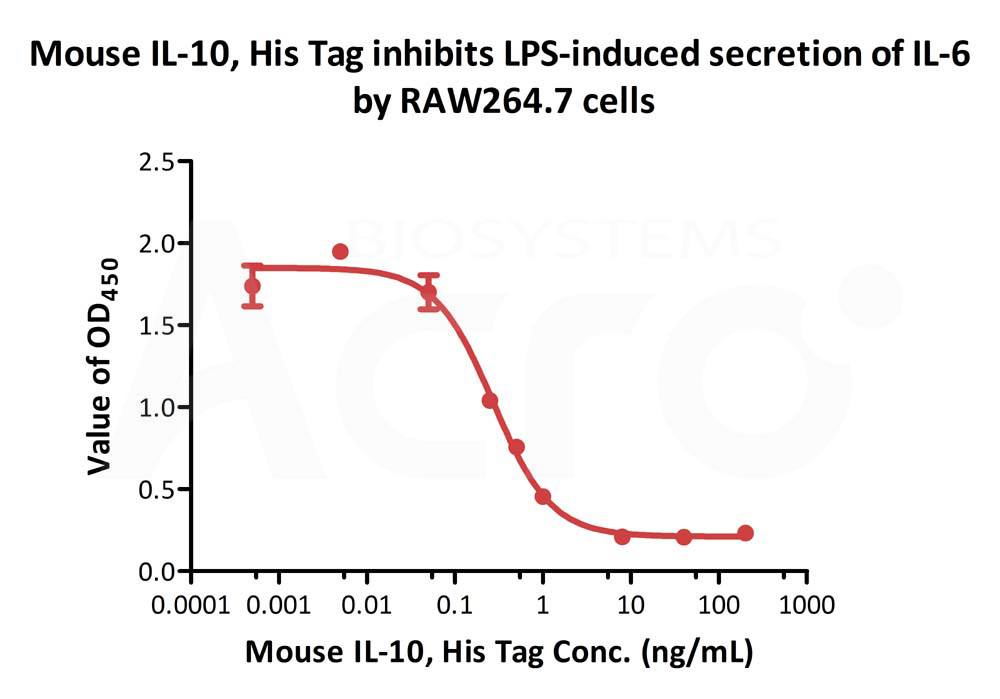分子别名(Synonym)
CSIF,IL-10,IL10A,TGIF,B-TCGF,GVHDS,MGC126450,MGC126451,RP11-262N9.1,Interleukin-10
表达区间及表达系统(Source)
Mouse IL-10, His Tag (IL0-M4248) is expressed from human 293 cells (HEK293). It contains AA Ser 19 - Ser 178 (Accession # NP_034678).
Predicted N-terminus: His
Request for sequence
蛋白结构(Molecular Characterization)

This protein carries a polyhistidine tag at the N-terminus.
The protein has a calculated MW of 19.6 kDa. The protein migrates as 22-25 kDa when calibrated against Star Ribbon Pre-stained Protein Marker under reducing (R) condition (SDS-PAGE) due to glycosylation.
内毒素(Endotoxin)
Less than 1.0 EU per μg by the LAL method.
纯度(Purity)
>92% as determined by SDS-PAGE.
制剂(Formulation)
Lyophilized from 0.22 μm filtered solution in PBS, pH7.4 with trehalose as protectant.
Contact us for customized product form or formulation.
重构方法(Reconstitution)
Please see Certificate of Analysis for specific instructions.
For best performance, we strongly recommend you to follow the reconstitution protocol provided in the CoA.
存储(Storage)
For long term storage, the product should be stored at lyophilized state at -20°C or lower.
Please avoid repeated freeze-thaw cycles.
This product is stable after storage at:
- -20°C to -70°C for 12 months in lyophilized state;
- -70°C for 3 months under sterile conditions after reconstitution.
电泳(SDS-PAGE)

Mouse IL-10, His Tag on SDS-PAGE under reducing (R) condition. The gel was stained with Coomassie Blue. The purity of the protein is greater than 92% (With Star Ribbon Pre-stained Protein Marker).
活性(Bioactivity)-Bioactivity CELL BASE

Mouse IL-10, His Tag (Cat. No. IL0-M4248) inhibits LPS-induced secretion of IL-6 by RAW264.7 cells. The EC50 for this effect is 0.27-0.39 ng/mL (Routinely tested).
Protocol
背景(Background)
Interleukin-10 (IL-10) is also known as human cytokine synthesis inhibitory factor (CSIF), is an anti-inflammatory cytokine. IL-10 is an immunosuppressive cytokine produced by a variety of mammalian cell types including macrophages, monocytes, T cells, B cells and keratinocytes. Mature human IL-10 shares 72% - 86% amino acid sequence identity with bovine, canine, equine, feline, mouse, ovine, porcine, and rat IL-10. Whereas human IL-10 is active on mouse cells, mouse IL-10 does not act on human cells. IL-10 is capable of inhibiting synthesis of pro-inflammatory cytokines such as IFN-γ, IL-2, IL-3, TNFα and GM-CSF made by cells such as macrophages and regulatory T-cells. It also displays a potent ability to suppress the antigen-presentation capacity of antigen presenting cells. However, it is also stimulatory towards certain T cells and mast cells and stimulates B cell maturation and antibody production. Knockout studies suggested the function of Interleukin-10 / IL-10 as an essential immunoregulator in the intestinal tract. Patients with Crohn's disease react favorably towards treatment with bacteria producing recombinant interleukin-10, showing the importance of interleukin-10 for counteracting excessive immunity in the human body.






















































 膜杰作
膜杰作 Star Staining
Star Staining











